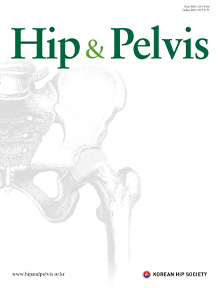Quick links
Related article in
-
Original ArticleDecember 31, 2014
 0
0
 75
75
 17
17

Efficacy of Debridement for Early Periprosthetic Joint Infection after Hip Arthroplasty
Jong Hoon Kim, MD, Sung Kwang Chun, MD, Yong Cheol Yoon, MD, Devendra Lakhotia, MS, Won Yong Shon, MD
Hip Pelvis 2014; 26(4): 227-234AbstractPurpose: In early prosthetic joint infection after hip arthroplasty, debridement with prosthesis retention may be performed for implant salvage, but the reported success rates are highly variable. Hence we reviewed the outcome of radical debridement and retention of prosthesis using established diagnostic criteria and surgical procedures in relation to significant variables including clinical characteristics, pathogenicity, and antibiotic treatment.
Materials and Methods: We retrospectively reviewed 20 patients (11 men and 9 women) with early prosthetic joint infection after unilateral hip arthroplasty, treated by radical debridement with retention of prosthesis from January 2000 to May 2011. Average follow-up period was 55 months (12-178 months). The outcome was evaluated and analyzed based on recurrence of infection and clinical (Harris hip score) and radiological criteria.
Results: Pathogens were isolated from 11 hips (methicillin-resistant Staphylococcus aureus [MRSA] in three, methicillin-resistant Staphylococcus epidermidis [MRSE] in two, methicillin-sensitive Staphylococcus aureus [MSSA] in one, Acinetobacter baumannii in two, Enterococcus faecalis in two patients, and Enterococcus, Citrobacter species in one). The mean duration of antibiotic administration was 43.5 days. Recurrence of infection was not observed in any case. Average Harris hip score was 91 points at the last follow-up. Revision surgery was not required for any reason including implant failure. Dislocation occurred in two hips after debridement and was treated conservatively.
Conclusion: Radical debridement with prosthesis retention is an effective procedure for early prosthetic joint infection after hip arthroplasty in carefully selected patients and with early diagnosis. -
Original ArticleMarch 31, 2023
 0
0
 110
110
 29
29

Total Hip Arthroplasty with Cemented Dual Mobility Cup into a Fully Porous Multihole Cup with Variable Angle Locking Screws for Acetabular Fractures in the Frail Elderly
Mathias van den Broek, MD
Hip Pelvis 2023; 35(1): 54-61 , Kris Govaers, MD, PhDAbstractPurpose: The purpose was to examine the clinical and radiological outcomes after surgical treatment of acetabular fractures with total hip arthroplasty with a dual mobility cup cemented into a porous multihole cup in the population of frail elderly patients.
, Kris Govaers, MD, PhDAbstractPurpose: The purpose was to examine the clinical and radiological outcomes after surgical treatment of acetabular fractures with total hip arthroplasty with a dual mobility cup cemented into a porous multihole cup in the population of frail elderly patients.
Materials and Methods: A retrospective review of 16 patients who underwent surgery (mean age, 76.7 years) with a mean follow-up period of 36.9 months was conducted. Following surgery, patients underwent postoperative follow-up at six weeks, three, six, and 12 months and clinical and radiological examinations were performed.
Results: Classification of fractures was based on the Letournel classification. Following surgery, all patients were allowed weight-bearing as tolerated immediately postoperative. Fourteen patients showed maintenance of preoperative mobility status at one year. The mean Harris hip score was 64.8 (range, 34.7-82.8) and 80.0 (range, 60.8-93.8) at three months and one year, respectively. The mortality rate was 12.5% at one year (2/16). Complications included heterotopic ossification (2/16), deep venous thrombosis (1/16), heamatoma (1/16), and femoral revision due to a Vancouver B2 fracture (1/16). No case of deep infection, dislocation, or implant loosening was reported.
Conclusion: Total hip arthroplasty using a dual mobility cup cemented into a porous multihole cup with locking screws resulted in a stable construct with a capacity for immediate weight-bearing as tolerated with rapid relief of pain. The findings of this study suggest that this procedure can be regarded as a safe method that has shown promising clinical and radiological outcomes for treatment of patients with medical frailty. -
Original ArticleJune 1, 2010
 0
0
 75
75
 15
15
Postoperative Delirium after Hip Arthroplasty in the Elderly
Sung Kwan Hwang, MD, PhD, Chang Ho Lee, MD
J Korean Hip Soc 2010; 22(2): 151-158AbstractPurpose: Our study was done to evaluate the influence of postoperative delirium on the prognosis of hip arthroplasty, and risk factors for postoperative delirium in individuals older than 65.
Materials and Methods: Among patients who received hip arthroplasty in our hospital (WCH) between March 2004 and March 2008, we chose 193 patients for our study after excluding patients who had preoperative delirium and who had a history of dementia and cognitive dysfunction. We divided our cohort of 193 patients into two groups, 131 patients with postoperative delirium and 62 patients without delirium. We checked for clinical results for hip arthroplasty. We checked for multiple factors related to delirium.
Results: The mean hospital stay was 42.4±14.0 in the delirium group and 20.4±4.3 in the control group; the difference was significant. The mean preoperative cumulative ambulation score was 1.9±1.2 in the delirium group and 3.1±1.7 in the control group; the difference was significant. In 2 individuals of the control group and 4 of the delirium group, dislocation developed;and there was significant difference. There was a high prevalence of delirium among patients with hip fractures, and of histories of psychiatric diseases, alcohol abuse, liver cirrhosis and cerebral vascular disease. The delirium group had a significantly longer stay in the intensive care unit. On admission, the delirium group had significantly lower sodium and albumin compared to controls.
Conclusion: Because postoperative delirium after hip arthroplasty makes the prognosis worse, preoperative evaluation and management of risk factors is necessary. -
Original ArticleMarch 1, 2006
 0
0
 65
65
 12
12
Acetabular Revision Using Acetabular Reinforcement Ring and Allograft Impaction
In Hwan Hwang, M.D., Soon Taek Jung, M.D., Sun Chul Hwang, M.D., Se Hyun Cho, M.D.
J Korean Hip Soc 2006; 18(1): 25-30AbstractPurpose: We wanted to evaluate the clinical and radiologic results of acetabular revision using the acetabular reinforcement ring and also the allograft impaction in the acetabulum having deficient bone stock.
Material and Methods: Nineteen hips revision arthroplasty were performed in 18 patients (9 males and 9 females) with using an acetabular reinforcement ring and allograft between July 1993 and December 2003. The patients were followed for an average of 64 months (range: 24-153). The mean age at the time of arthroplasty was 59 years old (range: 34-76). The causes of revision were aseptic loosening of the acetabular component in 16 cases, severe progressive osteolysis around the acetabular component in 2 cases and Girdlestone state after infected total hip arthroplasty in one case. The acetabular deficiency was type II in 5 hips, type III in 13 hips, and type IV in one hip according to the AAOS classification. The clinical results were evaluated using the modified Harris hip score, and the radiologic results were evaluated by assessing the preoperative and serial follow-up radiographs.
Results: The mean preoperative Harris hip score of 47 was improved to 86 points at the latest follow-up. Periacetabular osteolysis was found in 2 cases, which did not progress at follow-up. The anatomic hip center was restored after revision arthroplasty (p<0.05). Complications were dislocation in 2 cases, breakage of the hook of the Ganz ring in one case, heterotopic ossification in one case and femoral artery injury in one case. All cases showed stable fixation of the acetabular component and good remodelling of the impacted allograft. There was neither recurrence of dislocation nor progression of the acetabular component loosening on the radiographs.
Conclusion: Acetabular revision with acetabular reinforcement ring and allograft impaction showed satisfactory clinical and radiologic results with restoration of the hip center and consolidation of the allograft. -
Original ArticleMarch 1, 2008
 0
0
 46
46
 10
10
Revision Total Hip Replacement using a Cementless Wagner SL Femoral Stem
Se-Hyun Cho, M.D., Dong-Hee Kim, M.D., Soon-Taek Jeong, M.D., Hyung-Bin Park, M.D., Sun-Chul Hwang, M.D., Min-Seok Cha, M.D.
J Korean Hip Soc 2008; 20(1): 47-52AbstractPurpose: To evaluate the clinical and radiological changes of femoral revision with the Wagner SL stem.
Materials and Methods: 21 femoral revisions were performed in 21 patients (16 males and 5 females; mean age 58.9 years) between June 1997 and July 2005, utilizing the Wagner SL stem. The follow-up period was a mean of 31 months (range 25-84 months). Causes of revision included aseptic loosening (14 cases), periprosthetic fracture (4 cases), recurrent total hip dislocation (2 cases), and neglected bipolar hip dislocation (1 case). Greater trochanteric osteotomy was performed in 10 cases, and extended trochanteric osteotomy was performed in 6 cases. Clinical results were assessed using Harris hip score. Radiographic parameters such as stem subsidence, calcar atrophy, and stress-shielding were also assessed.
Results: The mean Harris hip score improved from 45.7 to 91.3. There was no removal of the implanted Wagner stem. One case of nonunion of the greater trochanter was treated by fixation with Dall-Miles cables and a trochanteric plate. There was one case of limb shortening of 2 cm.
Conclusion: The Wagner SL stem provided immediate stability and allowed early weight-bearing. Bony regeneration around the stem was achieved without resorting to a bone graft.
- 1

Vol.36 No.1
Mar 01, 2024, pp. 1~75
Most Keyword
?
What is Most Keyword?
- It is most registrated keyword in articles at this journal during for 2 years.
Most View
-
Pathophysiology and Treatment of Gout Arthritis; including Gout Arthritis of Hip Joint: A Literature Review
Yonghan Cha, MD
Hip Pelvis 2024; 36(1): 1-11 , Jongwon Lee, MD
, Jongwon Lee, MD  , Wonsik Choy, MD
, Wonsik Choy, MD  , Jae Sun Lee, PhD*,†
, Jae Sun Lee, PhD*,†  , Hyun Hee Lee, MD‡
, Hyun Hee Lee, MD‡  , Dong-Sik Chae, MD‡
, Dong-Sik Chae, MD‡ 
-
Treatment of Osteoporosis after Hip Fracture: Survey of the Korean Hip Society
Jung-Wee Park, MD
Hip Pelvis 2024; 36(1): 62-69 , Je-Hyun Yoo, MD*
, Je-Hyun Yoo, MD*  , Young-Kyun Lee, MD
, Young-Kyun Lee, MD  , Jong-Seok Park, MD†
, Jong-Seok Park, MD†  , Ye-Yeon Won, MD‡
, Ye-Yeon Won, MD‡ 
Editorial Office
Laboratory tests performed in hip fracture patients. CTX: carboxy-terminal telopeptide of collagen I, PTH: parathyroid hormone, P1NP: procollagen type I N propeptide, U/A: urinalysis.|@|~(^,^)~|@|First-line treatment option for osteoporosis in hip fracture patients. BP: bisphosphonate, PTH: parathyroid hormone, SERM: selective estrogen receptor modulator.|@|~(^,^)~|@|Osteoporosis medication in patients with rebound phenomenon after cessation of denosumab. Ca+Vit. D: calcium and vitamin D, PTH: parathyroid hormone, SERM: selective estrogen receptor modulator.|@|~(^,^)~|@|The most important recognized factor for atypical femoral fracture.|@|~(^,^)~|@|Preferred osteoporosis medications after cessation of bisphosphonate in patients with atypical femoral fracture. PTH: parathyroid hormone, Ca+Vit. D: calcium and vitamin D, SERM: selective estrogen receptor modulator.|@|~(^,^)~|@|Preferred osteoporosis medications in patients with high-risk of atypical femoral fracture. Ca+Vit. D: calcium and vitamin D, SERM: selective estrogen receptor modulator, PTH: parathyroid hormone.
Hip Pelvis 2024;36:62~69 https://doi.org/10.5371/hp.2024.36.1.62
© H&P
© 2024. The Korean Hip Society. Powered by INFOrang Co., Ltd




 Cite
Cite PDF
PDF



